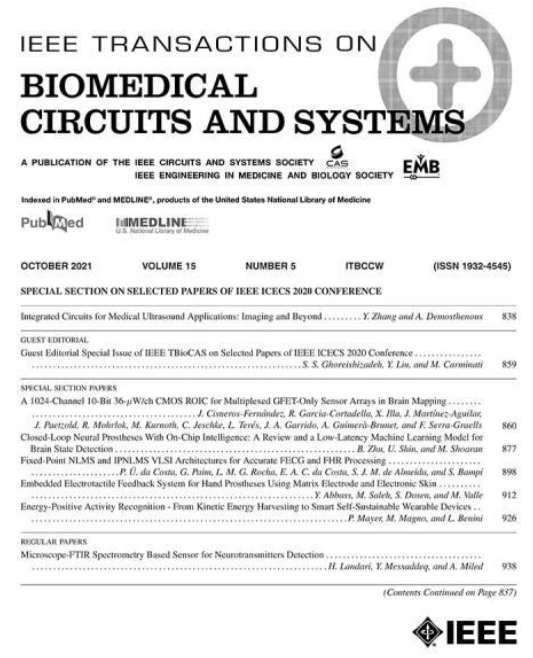A MEMS Interface IC With Low-Power and Wide-Range Frequency-to-Voltage Converter for Biomedical Applications
IF 4.9
2区 医学
Q2 ENGINEERING, BIOMEDICAL
IEEE Transactions on Biomedical Circuits and Systems
Pub Date : 2016-04-01
DOI:10.1109/TBCAS.2015.2435256
引用次数: 17
Abstract
This paper presents an interface circuit for capacitive and inductive MEMS biosensors using an oscillator and a charge pump based frequency-to-voltage converter. Frequency modulation using a differential crossed coupled oscillator is adopted to sense capacitive and inductive changes. The frequency-to-voltage converter is designed with a negative feedback system and external controlling parameters to adjust the sensitivity, dynamic range, and nominal point for the measurement. The sensitivity of the frequency-to-voltage converter is from 13.28 to 35.96 mV/MHz depending on external voltage and charging current. The sensitivity ranges of the capacitive and inductive interface circuit are 17.08 to 54.4 mV/pF and 32.11 to 82.88 mV/mH, respectively. A capacitive MEMS based pH sensor is also connected with the interface circuit to measure the high acidic gastric acid throughout the digestive tract. The sensitivity for pH from 1 to 3 is 191.4 mV/pH with 550 μV pp noise. The readout circuit is designed and fabricated using the UMC 0.18 μm CMOS technology. It occupies an area of 0.18 mm 2 and consumes 11.8 mW.具有低功耗和宽范围频率-电压转换器的生物医学应用MEMS接口IC
本文提出了一种电容式和电感式微机电系统生物传感器的接口电路,采用振荡器和电荷泵作为频率-电压转换器。采用差分交叉耦合振荡器进行调频,检测电容和电感的变化。频率-电压转换器设计了一个负反馈系统和外部控制参数来调节灵敏度,动态范围和标称点的测量。频率-电压转换器的灵敏度从13.28到35.96 mV/MHz取决于外部电压和充电电流。电容接口电路和电感接口电路的灵敏度范围分别为17.08 ~ 54.4 mV/pF和32.11 ~ 82.88 mV/mH。接口电路还连接了电容式MEMS pH传感器,用于测量整个消化道的高酸性胃酸。灵敏度为191.4 mV/pH,噪声为550 μV。读出电路采用UMC 0.18 μm CMOS工艺设计制作。它占地0.18 mm 2,消耗11.8 mW。
本文章由计算机程序翻译,如有差异,请以英文原文为准。
求助全文
约1分钟内获得全文
求助全文
来源期刊

IEEE Transactions on Biomedical Circuits and Systems
工程技术-工程:电子与电气
CiteScore
10.00
自引率
13.70%
发文量
174
审稿时长
3 months
期刊介绍:
The IEEE Transactions on Biomedical Circuits and Systems addresses areas at the crossroads of Circuits and Systems and Life Sciences. The main emphasis is on microelectronic issues in a wide range of applications found in life sciences, physical sciences and engineering. The primary goal of the journal is to bridge the unique scientific and technical activities of the Circuits and Systems Society to a wide variety of related areas such as: • Bioelectronics • Implantable and wearable electronics like cochlear and retinal prosthesis, motor control, etc. • Biotechnology sensor circuits, integrated systems, and networks • Micropower imaging technology • BioMEMS • Lab-on-chip Bio-nanotechnology • Organic Semiconductors • Biomedical Engineering • Genomics and Proteomics • Neuromorphic Engineering • Smart sensors • Low power micro- and nanoelectronics • Mixed-mode system-on-chip • Wireless technology • Gene circuits and molecular circuits • System biology • Brain science and engineering: such as neuro-informatics, neural prosthesis, cognitive engineering, brain computer interface • Healthcare: information technology for biomedical, epidemiology, and other related life science applications. General, theoretical, and application-oriented papers in the abovementioned technical areas with a Circuits and Systems perspective are encouraged to publish in TBioCAS. Of special interest are biomedical-oriented papers with a Circuits and Systems angle.
 求助内容:
求助内容: 应助结果提醒方式:
应助结果提醒方式:


